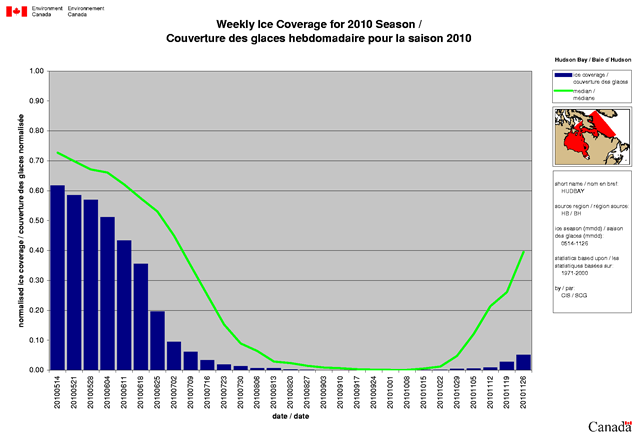Dramatic decline in sea ice imperils Western Hudson Bay polar bears – Bears went without eating this year for 3 weeks longer than usual
By Aislinn Maestas
12-07-2010 The polar bears of Western Hudson Bay went without eating this year for approximately 3 weeks longer than usual. According to the National Wildlife Federation, the combined early summer break-up of sea ice and delayed winter freeze-up foreshadows what is likely to be a fast-approaching and grim future for these polar bears. “The facts are impossible to ignore,” said Dr. Sterling Miller, senior biologist with the National Wildlife Federation. “These bears are spending longer periods off the ice, their body mass and reproductive rates have been steadily declining, and their numbers are dropping.” For nearly 5 months, Western Hudson Bay’s polar bears have had little to nothing to eat, relying on their dwindling fat stores for survival. In the 1970s, this period of fasting averaged about 120 days, after which they were able to return to the sea ice to hunt for seals, their primary food source. The fasting period for radio-marked bears this year was 140 days. “I recently returned from Churchill, Manitoba where I saw with my own eyes how climate change is transforming the region for polar bears,” said Dr. Miller. “At a time when they normally are out hunting for seals on the frozen ice during mid-November, they were all still on shore, looking forlornly at open water and waiting with increasing desperation for the ice to form up.” Unlike other populations of polar bears further north, the bears around Churchill spend part of the year on land because the ice on Hudson Bay completely melts during the summer. During this time, these polar bears must rely on their fat reserves for survival, eating next to nothing for months. The more time they must spend on land, the longer they go without eating. Once the ice forms up, the bears return to the ice to hunt and feed on seals. In a year like 2010, however, when the ice broke up exceptionally early in the summer and formed up exceptionally late (see graph right), it is likely that some bears, especially the young ones, will die even after they make it back out on the ice because their condition will be too poor to recover. According to Dr. Andrew Derocher, Professor of Biological Sciences at the University of Alberta and a Scientific Advisor to Polar Bears International, a leader in the conservation of polar bears, the first radio-marked bear came off the ice on June 25 this year, meaning that some bears have been on land for 163 days. “The Western Hudson Bay polar bears are experiencing two difficult situations in 2010: they were forced ashore 2-3 weeks earlier than what used to be considered normal,” said Derocher. “And they’ve also had to wait an extended period of time for the winter freeze up – which is also several weeks later than in the past.” A recent paper published in Biological Conservation co-authored by Derocher estimated that 3-6 percent of adult male polar bears in Western Hudson Bay would die of starvation with a fasting period of 120 days, but 28-48 percent would die if climate change increases the fasting period to 180 days. Females and cubs will be even less able to cope with the stresses of a shortened seal hunting period because their energetic demands are higher and the period of fasting, for pregnant females, is much longer. “The increasingly narrow timeframe for bears to hunt and feed on seals is a direct effect of climate change,” said Dr. Miller. “As a result, the Western Hudson Bay polar bear population has suffered a 22 percent decline since the early 1980s. The longer period they must spend fasting on land, the higher the mortality rates will climb and steeper will be the decline in reproductive rates.” …
Polar Bear Survival, Reproduction Threatened by Extended Period on Land
